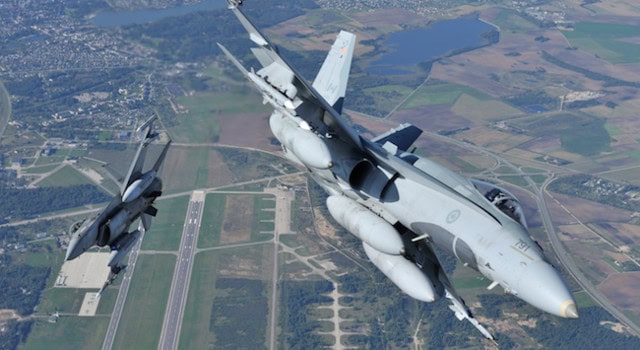
A fighter pilot has been fined $2,000 after pleading guilty at a court martial to flying his CF-18 jet too low during a training mission in which his wingman died in a crash.
Capt. Christopher Mileusnic was the leader of a two-aircraft formation on Nov. 28, 2016, that was practising dropping bombs on targets near the Cold Lake weapons range in northeastern Alberta.
The rules for the low altitude mission required that the aircraft have a working heads-up-display — a device that shows flight information that the pilot can read by looking forward at the canopy.
According to the agreed statement of facts, the pilots were under pressure to drop all of their bombs before returning to base.
Mileusnic’s heads-up-display was flickering, not showing consistent altitude information as required by flight rules.
Despite the problem he continued making bomb runs with his wingman, Capt. Thomas McQueen.
“During the last target run, Captain McQueen flew the target run-in at 450 feet AGL with Captain Mileusnic in a three mile trail position. While conducting the safe escape manoeuvre, Captain McQueen inadvertently flew into terrain and died instantly,” reads the statement of facts.
“The actions of Captain Mileusnic during the Swift flight are in no way alleged to have contributed to the crash and death of Captain McQueen.”
At Monday’s court martial Mileusnic pleaded guilty to flying an aircraft at a height less than the minimum height authorized in the circumstances.
He was also charged with negligently performing a military duty imposed on him and negligently committing an act deemed dangerous to life.
A military spokesman said the prosecutor decided not to proceed with the other charges following the guilty plea on the first charge.
The court martial judge then accepted a joint submission by the prosecutor and defence and sentenced Mileusnic to the fine.
An accident report released last April into the fatal crash suggested that McQueen was distracted and trying to see where a practice bomb had landed just before his CF-18 hit the ground.
The report said flight rules have since been changed to raise the acceptable altitude for such training to more than 300 metres and to underline safety standards for low flying.


